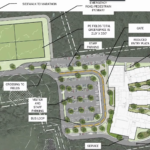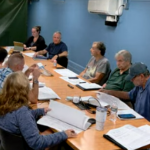The Planning Board at its meeting Monday night voted 8-0 to approve two longstanding projects — The Trails and the Grasshopper solar farm — after the respective applicants agreed to several conditions.
The Trails, an open-space mixed-use development (OSMUD) off Legacy Farms North Road, near the Ashland border, has been plagued by stormwater management issues that have negatively impacted the water system in Ashland, and violations were issued in the summer of 2021. Both the Conservation Commission and the Planning Board have been seeking plans to remedy the situation over the past several months. A peer consultant was brought in to review the stormwater management practices.
Project engineer Peter Bemis said that the proposed sidewalk at the entrance was the only outstanding issue that the Planning Board may need to review. A berm previously had been approved where the sidewalk with sloped granite curbing is proposed, he noted. The project received unanimous approval at the previous week’s Conservation Commission meeting.
Phil Paradis, the town’s engineering consultant from BETA Group, disagreed. He described the sidewalk issue as “back and forth” because it was proposed originally and then reinstated. He recommended that a vegetated buffer be used between the sidewalk and the road because it provides some stormwater infiltration and is in alignment with the look of the rest of the entire Legacy Farms development.
Another point he said he was “uneasy about” was the retaining wall behind 75-89 Weston Lane, which is adjacent to the Ashland town line at its lagoon. Because BETA was not there when it was constructed to observe the work, he did not want to take responsibility for it on behalf of the town. He said he prefers to have a more “hands-on approach.”
Said Paradis: “Our concern as professional engineers is that I don’t want to own it.”
He added that it was never designed as a boulder wall but rather as a retaining wall.
Bemis noted that he had an engineer who specializes in retaining walls inspect the work and provide a letter authenticating that it was done correctly to the board. Large boulders were placed at the limit of work to form the structure, which the consultant determined to be sound. Bemis said he considered boulders to be “time tested.”
Member Matthew Wronka asked if there was a way to “get a more definitive level of confidence” about the retaining wall.
Chair Gary Trendel said that building it veered from the original plans but that an engineer did review it to ensure that it was sound.
Bemis and Paradis debated about where the sidewalk should be placed. Bemis stressed that he did not want it to extend 75 feet into Legacy Farms Road because he believed it would jeopardize pedestrian safety on a road where he observed cars going 50 mph. He proposed adding additional pavement on the opposite side of the street.
“It’s extremely important to get that pedestrian traffic a little bit further west,” Bemis said, “so they’ll be a little bit more protected as they cross the road.”
The board approved the site plan after imposing 18 conditions, including requiring the applicant to be responsible for mitigating construction impacts such as erosion, noise and dust as well as adjusting the lighting to prevent light pollution.
Said Trendel: “We look forward to seeing that project finished off.”
Grasshopper landscaping plan approved with conditions
Grasshopper Energy’s 2.4-megawatt commercial solar farm between Wilson Street and Cedar Street also received unanimous approval of its updated plans despite the plans being submitted the day of the hearing. Materials are supposed to be received the Tuesday before the meeting. The board agreed to review the plans anyway in an effort to expedite the case after Trendel took the opinions of abutters Tom Shambo and Ed Cutter into account.
The plan revisions focused on the front entrance area and landscaping concerns raised by the abutters and board members at previous meetings. Electrical engineer Chris Balogh provided an update on how to shield the electrical boxes from view. There now will be a wooden fence surrounding the boxes instead of planter boxes, and there will be a scenic wooden fence at the entrance in front of them.
Trendel brought up that the boulder removal and revegetation plans for the disturbed buffer zone area did not appear on the plans.
Balogh said that the changes requested by the board at the last meeting were detailed in a letter he submitted. The board had to add several conditions to the approval because the letter is not considered a part of the approval package, according to Principal Planner John Gelcich.
At the last meeting, the board had asked for more detailed plans, particularly regarding the removal of boulders from the buffer zone and the access road, as well as the five-year maintenance plan for plantings. Some plantings and trees installed two years ago already have died or are in poor condition, according to the abutters. These details were not articulated in the revised plans.
Shambo said there were at least five dead trees that needed replacement.
Cutter called for “a fresh, healthy start” for the vegetation.
Green industrial fence screening will be added to shield the photovoltaic installation from the abutters’ view, and they insisted that it be dark green to better blend in with the tree canopy.
Member Ron Priefer called out vagaries in the letter about loaming and removing boulders “where applicable,” saying that he would have preferred “more minutiae detail.”
Trendel explained that “because the letter doesn’t mean anything,” the board has an opportunity to be specific in its conditions. If the conditions are not met, there is the potential for Grasshopper’s special permit to be revoked. One condition was that the mesh screening be maintained for the life of the solar array.
Another point of contention was the maintenance plan for the landscaping. The Grasshopper team initially proposed that the lawn be mowed biweekly, but Balogh said twice a season was more reasonable.
Shambo added that there was a dispute about the land reclamation area. The previous solar developer promised that trees would be planted there, he said. While Grasshopper proposed grass, Shambo said that only mowing it twice a season “seems a bit shallow.”
Trendel suggested seeding the area and letting it be reclaimed by the wild.
The boulder removal and initial landscaping must be performed by June 1, the board stipulated.
Said Trendel: “I think that if it isn’t done at the timeline that we specify in the conditions, then the next step would be to revoke the special permit.”
Turkey Ridge Estates open space plan updated
The Turkey Ridge Estates subdivision project, located at 52 Cedar Street Extension, near the Southborough border, has been plagued by weather-related problems that have caused its erosion control barriers to fail on several instances, sending turbid water toward the Sudbury River. Although the developer hired Goddard Consulting after the first incident on Dec. 29 and has made significant efforts toward remediation, additional violations recently prompted the Conservation Commission to leverage $31,800 in fines that had been held in abeyance for the first two violations.
Developer Shane Perrault said that debris and rocks have been removed from the open space area, which was going to be donated to the town for a trailhead. A stone retaining wall will be built, which Trendel said was “a nice visual reinforcement.” Red oak and red maple trees will be planted.
Gelcich added that Conservation Commission representatives requested that shrubs be added to prevent the spread of invasive Japanese knotweed. Perrault said the shrubs may overpopulate the trailhead, making it “not the right fit.” The board agreed that the shrubs were not necessary.
Perrault said he could provide a loam hydroseed with a New England mix and was “open to anything” the board suggested. He also stressed that there is a Japanese knotweed prevention plan in place and that efforts have been made over the past year to control its spread.
The proposal to donate the land to the town will be brought up at Town Meeting on May 1. There was a debate about whether the work could be done to restore the land before that date.
The board voted 8-0 to approve the acceptance of the land contingent on the work being completed.
Inclusionary Zoning Bylaw amendment approved
The Inclusionary Zoning Bylaw amendment was approved by a 6-2 vote after some debate over whether some affordable housing units were actually considered to be affordable based on the region’s area median income.
There was a discussion where Ted Barker-Hook said that the average teacher would not make enough money to purchase a home based on the area median income and the amount required now for an average down payment. He had cited one home where the down payment was $300,000.
The bylaw was proposed as a means to increase the affordable housing stock and prevent Chapter 40B developments being allowed by right.
Ten percent is the number of affordable housing units that Hopkinton needs to maintain to prevent developers from building affordable housing developments by right and getting around local zoning laws.
Board passes on Foxhollow Road acceptance
The acceptance of Foxhollow Road by the town was not recommended by the Planning Board due to its complex history.
Gelcich explained that the development and the road were approved in 2014. The developer later abandoned the project. He said that the portions of the road in front of each house actually belong to the individual property owners up to the road’s midpoint. Because of this, the road could not be deeded over to the town.
He added that the Department of Public Works said that work on a stormwater swale on a parcel of one unconstructed house needed to be completed before the town accepts the road. The house could be subject to basement flooding, and the DPW feared liability for the town should this happen.
Attorney Robert Finnegan spoke on behalf of the 10 homeowners on Foxhollow Road, saying the situation for them was “very dynamic.” He clarified that the swale between lots 11 and 12 had been built as part of the as-built plan. An issue was raised when a report by BETA was received last month.
Construction of the home is underway, he added. The swale had been reconstructed because of a “safety concern” of the site excavator trying to go around a house into conservation land. It can be modified with a few days of work. He asked that the road be accepted with the condition that the work be performed.
Finnegan also said he has spoken with town counsel and appeared before the land court on this matter. He said residents agreed to waive any claims to their portions of the road and sign indemnifications.
“None of the issues that this swale presents are in any way part of the land that the town will be taking,” he stressed, noting the concern about town liability.
“There’s a lot of what-ifs here,” Trendel said, noting that the board does not like to approve items based on conditions. “Given the complexities here, I think it’s really important that the work be done before we take a vote on it.”
He added that “it would be premature” to vote on the matter until the issues are resolved, and members concurred.
Hearings continued
The hearings for 86 Elm Street as well as 17 Pratt Way for the proposed pickleball/tennis facility were continued until the next meeting on April 24.






















0 Comments